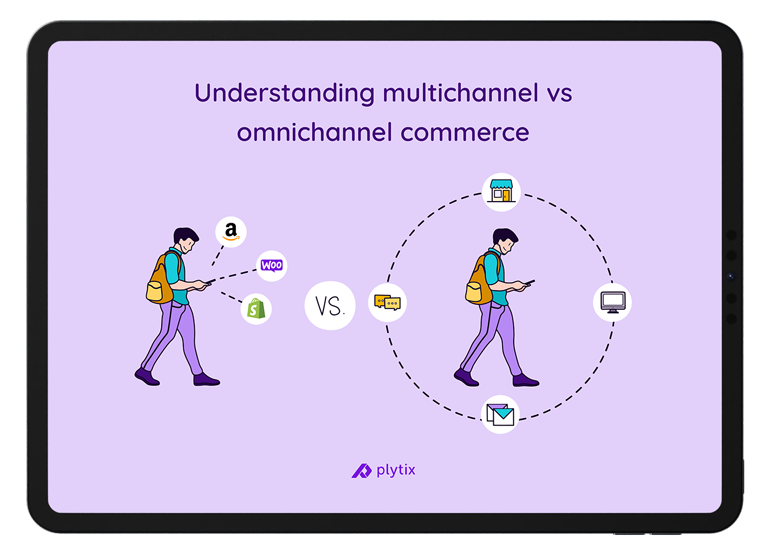Understanding multichannel vs omnichannel commerce
Multichannel and omnichannel commerce are selling strategies that help businesses reach buyers across multiple sales channels. While these strategies seem similar, the main difference lies in the buyer experience—making it important to differentiate between these two strategies.
Want to take this information with you? Get your downloadable version of this page here!
Get the downloadable version of this page


What is multichannel commerce?
Multichannel commerce (or multichannel retailing) is the strategy of selling your products or services on multiple sales channels. These channels could be your brick-and-mortar store, Amazon, Google Shopping, or wherever you’d want to sell. In this strategy, each channel functions independently. The goal of multichannel commerce is to reach as many customers as possible, all while giving them the option to buy your products on the channel they like the most.
An example of multichannel commerce is when a furniture company sells furniture through four different channels (like their physical store, their Shopify webstore, a mobile app, and Amazon). The furniture company manages each channel separately and caters to the needs of the buyers on each specific channel.

What is omnichannel commerce?
Omnichannel commerce (or omnichannel retailing) is the strategy of creating a seamless and integrated buyer experience across all the channels you sell from. In this strategy, the channels are interconnected and work together to create a unified buyer experience. The goal of omnichannel commerce is to provide buyers with a consistent and cohesive brand experience, regardless of the channel (or device) they choose.
For example, a customer searches for a product on a brand’s mobile app, adds the product to their cart, and then decides to complete the purchase on the brand’s webshop on a laptop. With an omnichannel experience, the product on the mobile app will show up on the webshop so that the customer can complete the purchase without having to start over.
What is the difference between omnichannel and multichannel commerce?

By looking at what multichannel and omnichannel commerce is, we can start to understand the differences. We know that multichannel commerce is a strategy that focuses on selling across multiple channels to reach a wider audience, while omnichannel commerce is a strategy that focuses on creating a holistic and consistent buyer experience.
Here’s a closer look at the difference between a multichannel and omnichannel commerce approach.
Multichannel Commerce |
Omnichannel Commerce |
|
|---|---|---|
| Definition | Selling your products or services on multiple sales channels | Creating a seamless, integrated experience across all the channels you sell from |
| Focus | Expanding product reach across buyers’ preferred channels | Providing a consistent brand experience |
| Buyer Experience | Separate experiences across channels | Unified and consistent experience across channels |
| Channel Integration | Channels function independently | Channels are interconnected and integrated |
| Branding | Branding could vary across channels | Consistent branding across all channels |
| Personalization | Limited personalization | More developed personalization |
| Complexity | Managing multiple independent channels | Integrating and aligning processes and systems across all channels |
Important note: In order to be able to implement a multichannel or omnichannel approach, you need to make sure your systems are set up for these types of selling. You need to adopt a headless commerce architecture.
What is headless commerce?

Headless commerce architecture is a new approach to building an ecommerce setup by decoupling (or separating) the frontend from the backend. You would remove the “head” (frontend) from the “body” (backend) for a more flexible and customizable solution compared to traditional ecommerce setups. And now that the head and the body are separate, they communicate to each other through Application Interface Programming (API).
This is the part of your website users see and interact with. This includes the user interface, design, layout, and the functionalities that users can see.
This is the system that makes everything on the frontend of the website work. This includes coding, processes, and any data management that users can’t see.


Headless commerce is necessary for you to be able to implement a multichannel or omnichannel commerce strategy because it allows you to customize your frontend on different platforms and integrate with third-party platforms more easily. You won’t be tied to one backend-frontend setup, which means you’ll save time and have more flexibility when adapting to different channels.
“Using a headless methodology offers you limitless possibilities since your back-end data is not coupled with a storefront. This allows you to adapt all of your content to different devices, platforms, and user interfaces easily.”

Ecommerce Specialist at Plytix

Here’s an example of how you could implement headless commerce.
Imagine you’re selling on your webshop, mobile app, Google Shopping, and Facebook Marketplace. You would tailor each user interface (specifically for your webshop and mobile app), and you would create third-party integrations for your Google Shopping and Facebook Marketplace accounts. And since you’ve decoupled your frontend from your backend, you can still use the same underlying ecommerce infrastructure for every single channel.
Here’s an example of how you could implement headless commerce.
Imagine you’re selling on your webshop, mobile app, Google Shopping, and Facebook Marketplace. You would tailor each user interface (specifically for your webshop and mobile app), and you would create third-party integrations for your Google Shopping and Facebook Marketplace accounts. And since you’ve decoupled your frontend from your backend, you can still use the same underlying ecommerce infrastructure for every single channel.
Types of sales channels in multichannel and omnichannel commerce

Social media platforms

Marketplaces

Mobile apps

Physical stores

Webshops

Comparison search engines
Social media platforms
Marketplaces
Mobile apps
Types of sales channels in multichannel and omnichannel commerce
Comparison search engines
Types of sales channels

Brick and mortar stores (or physical stores)

Webshops (or ecommerce websites)

Comparison search engines

Social media platforms

Marketplaces

Mobile apps
What are the benefits of multichannel and omnichannel commerce?
Multichannel commerce has unique advantages that brands can leverage for business success. And, the same can be said for omnichannel commerce. Let’s break them down:
Multichannel commerce benefits
By selling on different channels, you’ll tap into international markets and new customer groups that you never could by selling on just one or two channels.
Customers have their go-to shopping channels, so creating a multichannel presence gives you a higher chance of getting your products in front of those customers on the channels they like and use.

Expanding to more channels means you don’t have to depend solely on one channel to bring in all of the revenue. Not only that but having a greater online presence gives your customers more opportunities to engage with and buy your products.
But don’t just take our word for it—the numbers speak for themselves. A Sellbrite study found that merchants using three or more channels on average had 143% higher revenue than merchants selling on one or two channels.

Selling on the channels that your customers prefer makes buying your products more convenient for them.
When you adopt a multichannel practice, you’re not only increasing your own reach and sales but also giving your customers a better and more convenient experience. It’s a win-win for both you and your customers.

Omnichannel commerce benefits
Omnichannel commerce gives your customers a holistic and seamless experience. All of your sales channels come together to give your customer one full experience. Your customers can pick up right where they left off in the buyer's journey—making it easier and more enjoyable for them to shop with you.
These types of experiences are memorable and keep your customers coming back for more.

When all of your channels are in sync, you'll be able to keep customers engaged throughout all of your channels. By keeping them engaged no matter where they shop increases your chances of converting your customers across all your channels.
Customers will feel comfortable shopping on any of your channels knowing that they'll receive the same high-quality experience no matter what.

With omnichannel commerce, you'll have a lot of data around your customers and their behavior. This type of data can give you insights on how to better personalize and tailor the customer journey. You'll be able to create personalized shopping experiences with tailored marketing campaigns, messaging, and content.
And, trust us, customers love personalization. They love it so much that they are 80% more likely to buy from a brand with personalized experiences.

What are the challenges of multichannel and omnichannel commerce?
The more channels you sell from, the more challenges you’re bound to face. Let’s dive into the different challenges that each sales approach has.
Multichannel commerce challenges

Siloed buyer experience
With multichannel commerce, most businesses manage each channel independently without integrating the shopping experience across all channels. This can lead to a fragmented buyer experience when customers shop between different channels.


Inconsistent branding
Since each channel works independently, it can be difficult to create and maintain consistent messaging across all your channels. Not only that, but there are different requirements for each channel—making it even harder to keep your brand content and messaging the same.


Complex channel management
Multichannel commerce is about more than just getting your product on to different sales channels. There's a lot that goes into it. From inventory and product syndication to fulfillment and customer service, you have to manage all of these aspects for every channel you're on.
Omnichannel commerce challenges

Ineffective channel integration
When connecting your channels together for a seamless shopping experience, you have to do it right. If you don't, you might lose data or mismatch during the implementation stage. Make sure you have a solid omnichannel integration strategy so that you can avoid mistakes that typically occur when going omnichannel.


Channel conflicts
Channel conflicts are when the information about a product is different on different channels. This can come from varying channel requirements or not successfully updating your products across all channels. It's important to prevent channel conflicts in omnichannel commerce, so you can give your customers a seamless shopping experience.


Data management and privacy
To give your customers an integrated experience across all channels, you'll need to collect, manage, and analyze your customer data. This means you'll need to implement data governance policies to make sure you comply with privacy regulations and maintain data security.
Next steps in exploring multichannel and omnichannel commerce

Your journey in understanding multichannel or omnichannel commerce doesn’t stop here. That’s why we created a white paper on each selling strategy to help you better understand which one is the best fit for you. We even included some extra tips on how to get started for when you’re ready to adopt your newest selling strategy.
So go ahead, download whichever one you’d like! Or even both, because, why not? They’re free!
Have questions about Plytix?
Book a demo! Our sales experts will talk you through everything you need to know to make the best decision.

